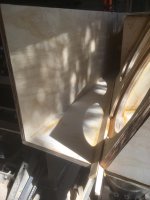Quasi-6th-order series tuned bandpass design
Hi all, I’m starting to present ?new? type bandpass enclosure - quasi-6th-order (BPQ6) series tuned bandpass. What do you think about?
Generalized design schematic will be:
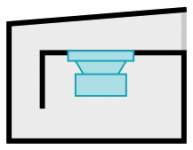
Let`s get started
It is intended to use mainly for fast response (tight bass) along with huge (2.5-3 octaves) flat response – you can get as low as detailed bass (and even infrasound) with it. And this is packed in minimal volume.
BPQ6 can be thought as generic ported (bass reflex) box but with driver(s) inside the port. Similar as quarter wave tubes can be transformed into tapped horn with same action. Also it is special case of series tuned 6-th order bandpass with zero front chamber volume.
Works great as home sub and as a car sub (with EQ-ed for you liking) – thanks to it flat response.
Main idea have next features:
- Need to get long-stroke driver with moderate or small moving mass for similar class. Driver will face big excursions around system low end tuning freq. Such driver can be tend working bad in ported box at desired low frequencies and peaking after system tuning freq, if you notice it – this driver can pretend to test&play within BPQ6. For example, optimal variant for 10 inch is 400W with Xmax 15mm (one side) for low end tuning @20Hz
- No massive and high power SPL subs can be applied – very stiff and heavy moving mass, with they you get huge narrow peak at low tuning frequency and silence around it. Also it’s excessive power will not be used at all via bad response and excursion limit
- BPQ6can be and must be tuned as low as possible while maintain flat response (key to low group delay) – with this “hack” we move bad group delay at tuning frequency deep into low hz zone. For ex. @20Hz we get some hurricane 🙂 and don’t rely delays as important as for ex. @50Hz, because main sound content lies in better hearing sound range after ~30Hz, and lowest end using primarily for it's “effects” or filtered at all
- Increased efficiency at high end up to second high end tuning frequency (key to “fast bass” and wider response), similar to 6-th order subs, but stronger. Simple ported boxes does not have this effect. Port tapering (horn) can greatly boost this effect. This feature can be used in various ways: supporting driver output at high end if using some heavy driver (you can be sometimes surprised what *this* driver can do, simple ported boxes cannot get this effect)
- 6-th order series tuned bandpass with front chamber can have similar effect, but front chamber leads to more delay and less cleaner sound and narrower response
- setting it high and filtering via filter or/and stuffing – you can still get increased response before it but remove unneeded group delays at tuning frequency simply not using it
- filtering it smart way – via configured filter to make response flat up to that tuning frequency. Use it if you need reach wider response, but with rapid roll-off at end
- Tuning overall response curve without changing tuning frequencies via driver placement in port, and if driver placed at part side, part can be rotated at 180° and installed in place without remake – I always do tests in either positions to find it best
- Smaller size for getting same low end response comparing to series tuned 6-th order bandpass, it is special case with zero front chamber volume. BPQ6 is smaller than 6-th order series tuned bandpass for same low end tuning freq. By adding front chamber you lowering high end tuning frequency and smoothing peak at it
- Easy response recording – place microphone near single port
My driver, for example, far from SQ (maybe 🙂) – it is – Machete M10 D2+2 (Alphard / Deaf bonce brand) – you can find it thiele-small params for reference (params working, no big mistakes, basic of it I test myself and approve).
I have 2 designs for now – Tesseractus and cyclops. All images, hornresp screenshots and real responces see in attachments. Also here 2 txt files - hornresp projects.
Attachments
-
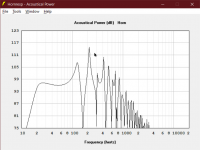 Hornresp_Ek7GE6gNOf.png49.5 KB · Views: 389
Hornresp_Ek7GE6gNOf.png49.5 KB · Views: 389 -
 DSC01832.jpg225.8 KB · Views: 402
DSC01832.jpg225.8 KB · Views: 402 -
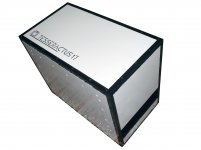 DSC01864.jpg131.9 KB · Views: 411
DSC01864.jpg131.9 KB · Views: 411 -
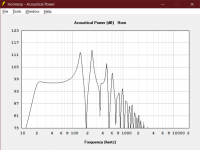 Hornresp_gMzFLtSF9O.png48.6 KB · Views: 437
Hornresp_gMzFLtSF9O.png48.6 KB · Views: 437 -
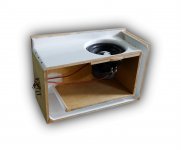 final4-web.jpg132 KB · Views: 439
final4-web.jpg132 KB · Views: 439 -
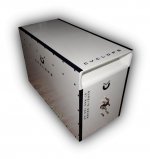 final2.jpg182 KB · Views: 235
final2.jpg182 KB · Views: 235 -
cyclops.txt1,017 bytes · Views: 79
-
tesseractus.txt1,018 bytes · Views: 90
-
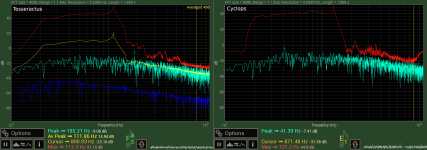 Real-responces.png190.3 KB · Views: 239
Real-responces.png190.3 KB · Views: 239
high compression ratio
Hi Makaan,
Interesting compact design, as for the tesseractus the ratio is 4.13:1 will it tear up the cone at high spl?
Hi Makaan,
Interesting compact design, as for the tesseractus the ratio is 4.13:1 will it tear up the cone at high spl?
for my setup it's stable, no problem with excursion overload even on 400W - tesseractus works more than 5 years (created in 2016). I created it as first "prototype" for BPQ6 design for maximum compactness in first place, and it's have some port noise (75 sq cm exit) near 20hz if listening in house (in car no problem at all)
Interesting design. How does it compare to a vented alignment of the same net volume?
Possible issues I can see are getting access to the driver and vent compression. But it does offer physical protection for the driver's cone.
Possible issues I can see are getting access to the driver and vent compression. But it does offer physical protection for the driver's cone.
For future access i always leave one side unglued - screws and sealing silicone gel only.
Compression issue can be noticeable for these 2 designs only after ~350W (near to maximum design rating), but really not as bad as you can think (in hornresp airspeed ~30m/s @20hz for Tesseractus and 20m/s for Cyclops).
Compression issue can be noticeable for these 2 designs only after ~350W (near to maximum design rating), but really not as bad as you can think (in hornresp airspeed ~30m/s @20hz for Tesseractus and 20m/s for Cyclops).
Hi Makaan,
nice design.🙂 But one question:
could you say something about the max SPL? What is the behavior of the sub/driver, if you increase the level to the maximum?
nice design.🙂 But one question:
could you say something about the max SPL? What is the behavior of the sub/driver, if you increase the level to the maximum?
Hi, I don't measure SPL yett, but his designs is for 400W max - on ~30hz it reaches Xmax ratings of 14mm one way (if suitable driver selected).
Tesseractus build for maximum compactness. (28x50x40cm)
Cyclops is for more quality sound and perfomance. (28x75x40cm)
For latest researches, seems new Sundown SD-4 series must run good for this setup, also good simulated to double driver version.
For upscale here is a good variant - Gladen SQL 12 - it must work .
.
For ex.
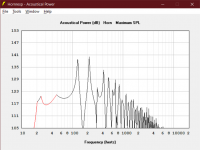
Is for Tesseractus in-corner.
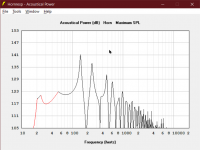
Is for Cyclops in-corner.
To get max of it, you have 2 choises - working as SPL on ~20-25Hz with strong-sloped filters on both sides OR set subsonic to 40Hz and play all above it.
Tesseractus build for maximum compactness. (28x50x40cm)
Cyclops is for more quality sound and perfomance. (28x75x40cm)
For latest researches, seems new Sundown SD-4 series must run good for this setup, also good simulated to double driver version.
For upscale here is a good variant - Gladen SQL 12 - it must work
 .
.For ex.

Is for Tesseractus in-corner.

Is for Cyclops in-corner.
To get max of it, you have 2 choises - working as SPL on ~20-25Hz with strong-sloped filters on both sides OR set subsonic to 40Hz and play all above it.
mcn 55-2421
Would it's work with this cheap driver assume same cabinet dimension or smaller? does have to be that low ...~37Hz. Thanks
https://www.farnell.com/datasheets/2329567.pdf
Would it's work with this cheap driver assume same cabinet dimension or smaller? does have to be that low ...~37Hz. Thanks
https://www.farnell.com/datasheets/2329567.pdf
I made some initial simulations with mcm 55-2421, and it not works in single (always peaking at low end tuning freq), and with it i can not get compact design.
Good results with double variant, but final dimensions will be ~same (or maybe slightly more) as Tesseractus. Port area will be around 80sq.cm and small chamber volume 10 liters. Works in 30-100hz zone (can not setup lower - peaking at low end, again). For max SPL chart Xmax=8mm.
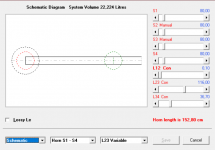
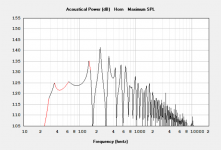
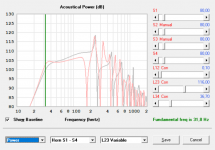
You can increase port area with it's length / or with chamber volume if needed to save same working range.
Good results with double variant, but final dimensions will be ~same (or maybe slightly more) as Tesseractus. Port area will be around 80sq.cm and small chamber volume 10 liters. Works in 30-100hz zone (can not setup lower - peaking at low end, again). For max SPL chart Xmax=8mm.



You can increase port area with it's length / or with chamber volume if needed to save same working range.
This idea is legit. definitely worth while, IMhO. I had a version of it in the past and it was quite good . I was a rookie so it wasn’t very well simmed or thought out but it was very energetic like a transflex or similar? Yours looks much nicer 😀😀 opposed Rockford Fosgste P3d2 570cm2 drivers.
Attachments
This idea is legit. definitely worth while, IMhO. I had a version of it in the past and it was quite good . I was a rookie so it wasn’t very well simmed or thought out but it was very energetic like a transflex or similar? Yours looks much nicer 😀😀
- Home
- Loudspeakers
- Subwoofers
- Quasi-6th-order series tuned bandpass design
